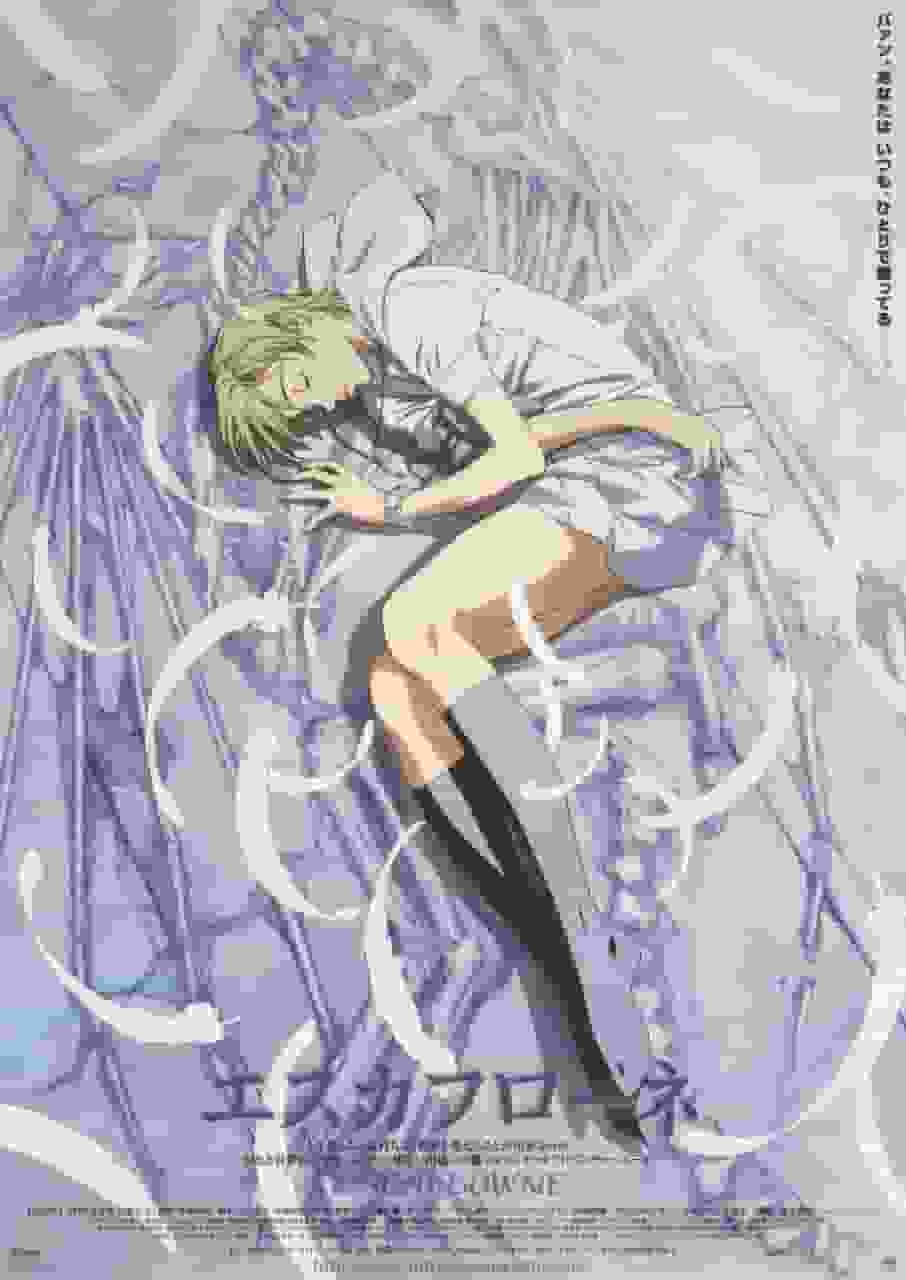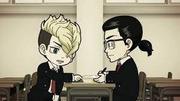Escaflowne: epic fantasy and deep storytelling

Escaflowne - The intersection of another world and youth■ Public Mediatheater ■ Original MediaAnime Original ■ Release dateJune 24, 2000 - January 1, 2000 ■Distribution companyOmega Project ■ Eirin Number115862 ■Frequencies110 minutes ■ Number of EpisodesEpisode 1 ■Original StoryOriginal story by Hajime Yatate and Shoji Kawamori ■ Director・Director: Kazuki Akane ■ Production・Produced by Sunrice ■Works©Sunrise Bandai Visual ■ Story Hitomi Kanzaki, a high school senior who is seized by a sense of emptiness, is despairing at herself for hurting even her best friend. This feeling triggers her to suddenly be transported to another world, Gaia. The first person Hitomi meets in Gaia is a boy named Van. Van is the young king of the extinct White Dragon Tribe, and a closed-hearted boy who resists the Black Dragon Tribe, led by the tactician Volken who summoned Hitomi, who is plotting to rule the world with fear. ■ Main staff Original story by Hajime Yatate and Shoji Kawamori ■ Related works・[TVA] 96.04.02-96.09.24 Escaflowne (all 26 episodes) Escaflowne - The intersection of another world and youthEscaflowne is an animated feature film based on the 1996 TV anime series Escaflowne. It was released on June 24, 2000, directed by Akane Kazuki and produced by Sunrise. The story follows Kanzaki Hitomi, a high school senior tormented by a sense of emptiness, who is transported to another world, Gaia, where she meets Van and fights alongside him. The appeal of the storyThe story of Escaflowne has a unique charm where the conflicts of youth and fantasy of another world intersect. The protagonist, Kanzaki Hitomi, is tormented by a sense of emptiness due to the guilt of having hurt her best friend. Meanwhile, she is transported to another world, Gaia, where she meets Van, the young king of the extinct White Dragon Tribe. Van is a boy who has closed his heart, and together with Hitomi, he faces off against Folken, the military strategist of the Black Dragon Tribe. The episode where Hitomi is called the "Winged God" by Gaia symbolizes her growth and self-discovery. The incident where she transforms the armor of the legendary dragon Escaflowne into a small red stone symbolizes Hitomi's power and destiny. Her process of discovering her own value while fighting alongside Van is a beautiful story that depicts the suffering and hope of youth. Character AppealEach character in Escaflowne has a deep background and a story of growth. The main character, Kanzaki Hitomi, is a high school student who is tormented by a sense of emptiness, but she is portrayed as someone who begins to believe in her own powers in a different world. Her growth resonates with viewers. Van is the young king of the extinct White Dragon tribe and a boy with a closed heart. His conflict between his past and present changes when he meets Hitomi. Van's character is a fascinating one, combining the strength of a warrior with inner fragility. The tactician, Folken, is a ruthless character who leads the Black Dragon Clan, but there is a deeper reason behind his actions, and as the story progresses, the background becomes clear. Folken's character is portrayed not as a simple villain, but as a complex human being. Visuals and MusicThe visuals of Escaflowne are characterized by character designs by Nobuteru Yuki and mecha designs by Kimitoshi Yamane. Escaflowne's design in particular is an impressive visual that combines beauty and strength. In addition, the scenery and battle scenes of the other world Gaia are also attractive for their detailed depictions. The music was composed by Yoko Kanno and Hajime Mizoguchi, and is an important element in enhancing the atmosphere of the story. Yoko Kanno's music in particular skillfully expresses the mystique of another world and the emotions of youth. The tension in the battle scenes and the emotionally rich music in the scenes depicting the inner workings of Hitomi and Van capture the hearts of viewers. Comparison with related worksEscaflowne is closely related to the TV anime "Escaflowne". The TV anime version is 26 episodes long and depicts the story of Hitomi and Van from their first meeting to their parting. The movie version condenses the essence of the TV anime version while depicting the story from a new perspective. The TV anime version depicts the relationship between Hitomi and Van and the detailed setting of the world of Gaia. On the other hand, the movie version focuses on Hitomi's inner conflict and growth, and has a more compact story development. By comparing the two, you can gain a deeper understanding of the worldview of Escaflowne and the appeal of its characters. Ratings and RecommendationsEscaflowne is a beautiful story where the conflicts of youth intersect with fantasy of another world. Each element, including character design, mecha design, and music, is fused together at a high level, deeply moving viewers. In particular, Hitomi's growth and her relationship with Van have been praised as a moving story that depicts the struggles and hopes of youth. This work is recommended for those who like fantasy and coming-of-age dramas set in other worlds. It is also recommended for those who are interested in character and mecha design, and those who enjoy Yoko Kanno's music. Escaflowne is a timeless masterpiece that gives viewers deep emotion and empathy. Further information and recommendationsEscaflowne is an animated feature film based on the 1996 TV anime series Escaflowne. It was released on June 24, 2000, directed by Akane Kazuki and produced by Sunrise. The story follows Kanzaki Hitomi, a high school senior tormented by a sense of emptiness, who is transported to another world, Gaia, where she meets Van and fights alongside him. The story of Escaflowne has a unique charm where the conflicts of youth and fantasy of another world intersect. The protagonist, Kanzaki Hitomi, is tormented by a sense of emptiness due to the guilt of having hurt her best friend. Meanwhile, she is transported to another world, Gaia, where she meets Van, the young king of the extinct White Dragon Tribe. Van is a boy who has closed his heart, and together with Hitomi, he faces off against Folken, the military strategist of the Black Dragon Tribe. The episode where Hitomi is called the "Winged God" by Gaia symbolizes her growth and self-discovery. The incident where she transforms the armor of the legendary dragon Escaflowne into a small red stone symbolizes Hitomi's power and destiny. Her process of discovering her own value while fighting alongside Van is a beautiful story that depicts the suffering and hope of youth. Each character in Escaflowne has a deep background and a story of growth. The main character, Kanzaki Hitomi, is a high school student who is tormented by a sense of emptiness, but she is portrayed as someone who begins to believe in her own powers in a different world. Her growth resonates with viewers. Van is the young king of the extinct White Dragon tribe and a boy with a closed heart. His conflict between his past and present changes when he meets Hitomi. Van's character is a fascinating one, combining the strength of a warrior with inner fragility. The tactician, Folken, is a ruthless character who leads the Black Dragon Clan, but there is a deeper reason behind his actions, and as the story progresses, the background becomes clear. Folken's character is portrayed not as a simple villain, but as a complex human being. The visuals of Escaflowne are characterized by character designs by Nobuteru Yuki and mecha designs by Kimitoshi Yamane. Escaflowne's design in particular is an impressive visual that combines beauty and strength. In addition, the scenery and battle scenes of the other world Gaia are also attractive for their detailed depictions. The music was composed by Yoko Kanno and Hajime Mizoguchi, and is an important element in enhancing the atmosphere of the story. Yoko Kanno's music in particular skillfully expresses the mystique of another world and the emotions of youth. The tension in the battle scenes and the emotionally rich music in the scenes depicting the inner workings of Hitomi and Van capture the hearts of viewers. Escaflowne is closely related to the TV anime "Escaflowne". The TV anime version is 26 episodes long and depicts the story of Hitomi and Van from their first meeting to their parting. The movie version condenses the essence of the TV anime version while depicting the story from a new perspective. The TV anime version depicts the relationship between Hitomi and Van and the detailed setting of the world of Gaia. On the other hand, the movie version focuses on Hitomi's inner conflict and growth, and has a more compact story development. By comparing the two, you can gain a deeper understanding of the worldview of Escaflowne and the appeal of its characters. Escaflowne is a beautiful story where the conflicts of youth intersect with fantasy of another world. Each element, including character design, mecha design, and music, is fused at a high level, deeply moving viewers. In particular, Hitomi's growth and her relationship with Van have been praised as a moving story that depicts the struggles and hopes of youth. This work is recommended for those who like fantasy and coming-of-age dramas set in other worlds. It is also recommended for those who are interested in character and mecha design, and those who enjoy Yoko Kanno's music. Escaflowne is a timeless masterpiece that gives viewers deep emotion and empathy. |
<<: Hamtaro: A thorough review of the hamster story of healing and adventure
Recommend
The appeal and reviews of "Bats & Terry": A deep look into the story of baseball and youth
Batz & Terry: Youthful brilliance and crazy a...
The appeal and evaluation of Happy Seven ~The TV Manga~
Happy Seven ~The TV Manga~ Review and Recommendat...
Is there a post-credits Easter egg in "Fast & Furious Hobbs & Shaw"?
Post-credits Easter eggs in movies are becoming m...
July 22 is the day of One Piece. The official release of the new Wano Country art and commemorative plans
The extremely popular anime "One Piece"...
Wu Jing's "The Climbers" international version trailer will be released simultaneously in North America and the UK on September 30
Today (September 23), the official release of &qu...
The new poster of the movie "Tomorrow's War" shows the mighty mecha shape
Today (July 27), the mecha hard science fiction m...
"Sword Art Online" "Officially released today" Officially releases anniversary gift box
In the world view of the light novel "Sword ...
A thorough analysis of the appeal and emotion of Yumemiru Jump! Reevaluating the masterpieces of Minna no Uta
"Dreaming Jump" - The appeal of Minna n...
Joaquin Phoenix to play Napoleon in new film 'Soldier's Bag'
According to foreign media Deadline: Ridley Scott...
Ang Lee talks about the impact of online movies on cinemas: We can’t force audiences to go to the cinema
Ang Lee talked about the impact of the epidemic o...
The new "Charlie's Angels" has an IGN score of 8.1, an M-site average score of 54, and only a 3-point score on iMDb
Sony Pictures' new "Charlie's Angels...
The appeal and evaluation of the Kinnikuman series: Powerful story and character depth
Kinnikuman - Great Space Superhuman Battle! ■ Pub...
The new movie version of Anpanman will be released on June 24, with Kitagawa Keiko making a guest appearance
The latest theatrical version of the legendary ma...
That warm big fat guy! The final trailer of Hayao Miyazaki's masterpiece "My Neighbor Totoro" will be released in China next week
One of Studio Ghibli's masterpieces, Hayao Mi...
Marvel's "Falcon and the Winter Soldier" miniseries starts filming in October! The timeline is after the end of the game
The latest issue of Men's Health magazine int...









